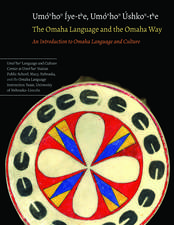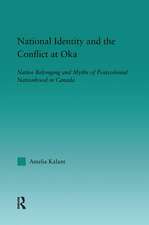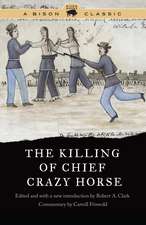Religious Revitalization among the Kiowas: The Ghost Dance, Peyote, and Christianity
Autor Benjamin R. Krachten Limba Engleză Hardback – apr 2018
Framed by theories of syncretism and revitalization, Religious Revitalization among the Kiowas examines changes in Kiowa belief and ritual in the final decades of the nineteenth century. During the height of the horse-and-bison culture, Kiowa beliefs were founded in the notion of daudau, a force permeating the universe that was accessible through vision quests. Following the end of the Southern Plains wars in 1875, the Kiowas were confined within the boundaries of the Kiowa-Comanche-Apache (Plains Apache) Reservation. As wards of the government, they witnessed the extinction of the bison herds, which led to the collapse of the Sun Dance by 1890. Though prophet movements in the 1880s had failed to restore the bison, other religions emerged to fill the void left by the loss of the Sun Dance. Kiowas now sought daudau through the Ghost Dance, Christianity, and the Peyote religion.
Religious Revitalization among the Kiowas examines the historical and sociocultural conditions that spawned the new religions that arrived in Kiowa country at the end of the nineteenth century, as well as Native and non-Native reactions to them. A thorough examination of these sources reveals how resilient and adaptable the Kiowas were in the face of cultural genocide between 1883 and 1933. Although the prophet movements and the Ghost Dance were short-lived, Christianity and the Native American Church have persevered into the twenty-first century. Benjamin R. Kracht shows how Kiowa traditions and spirituality were amalgamated into the new religions, creating a distinctive Kiowa identity.
Religious Revitalization among the Kiowas examines the historical and sociocultural conditions that spawned the new religions that arrived in Kiowa country at the end of the nineteenth century, as well as Native and non-Native reactions to them. A thorough examination of these sources reveals how resilient and adaptable the Kiowas were in the face of cultural genocide between 1883 and 1933. Although the prophet movements and the Ghost Dance were short-lived, Christianity and the Native American Church have persevered into the twenty-first century. Benjamin R. Kracht shows how Kiowa traditions and spirituality were amalgamated into the new religions, creating a distinctive Kiowa identity.
Preț: 451.37 lei
Preț vechi: 531.03 lei
-15% Nou
Puncte Express: 677
Preț estimativ în valută:
86.37€ • 92.36$ • 72.01£
86.37€ • 92.36$ • 72.01£
Carte tipărită la comandă
Livrare economică 17 aprilie-01 mai
Preluare comenzi: 021 569.72.76
Specificații
ISBN-13: 9781496204585
ISBN-10: 1496204581
Pagini: 342
Ilustrații: 8 photographs, 3 illustrations, index
Dimensiuni: 152 x 229 x 31 mm
Greutate: 0.65 kg
Editura: Nebraska
Colecția University of Nebraska Press
Locul publicării:United States
ISBN-10: 1496204581
Pagini: 342
Ilustrații: 8 photographs, 3 illustrations, index
Dimensiuni: 152 x 229 x 31 mm
Greutate: 0.65 kg
Editura: Nebraska
Colecția University of Nebraska Press
Locul publicării:United States
Notă biografică
Benjamin R. Kracht is a professor of anthropology at Northeastern State University in Tahlequah, Oklahoma. He is the author of Kiowa Belief and Ritual (Nebraska, 2017).
Cuprins
List of Illustrations
Kiowa Pronunciations
Preface
Acknowledgments
Introduction: Kiowa Culture in the Nineteenth Century
1. Christianity, Peyotism, Shamanism, and Prophecy from the Reservation Period to Statehood, 1869–1906
2. The Ghost Dance, 1890–1916
3. Christianity and Peyotism in the Postallotment Era
4. Peyotism and Christianity after World War II
Conclusion: Indigenized Christianity and Spirituality
Notes
References
Index
Kiowa Pronunciations
Preface
Acknowledgments
Introduction: Kiowa Culture in the Nineteenth Century
1. Christianity, Peyotism, Shamanism, and Prophecy from the Reservation Period to Statehood, 1869–1906
2. The Ghost Dance, 1890–1916
3. Christianity and Peyotism in the Postallotment Era
4. Peyotism and Christianity after World War II
Conclusion: Indigenized Christianity and Spirituality
Notes
References
Index
Recenzii
“Encyclopedic. . . . The Santa Fe materials take center stage but are also supplemented by previous and subsequent research by scholars like Mooney. The result is what could hardly be imagined as a more complete summary of a people’s beliefs and rituals at a particular moment in time—a moment that had just ended when the data were collected and that, despite all of the tribulations and losses faced by the Kiowa, continues not only to be remembered but to reverberate through their culture.”—Jack David Eller, Anthropology Review Database
"Benjamin R Kracht's new book Religious Revitalization Among the Kiowas: The Ghost Dance, Peyote, and Christianity explores the often-intertwined histories of the Kiowa Ghost Dance, the Native American Church, and indigenous Christianity through the lens of revitalization movements. . . . This is a strong work in the field of anthropology of religion."—Angela Tarango, Reading Religion
"This is a landmark contribution on Native American resistance to colonization, missionization, and domination by Euro-American settlers. . . . [Kracht's] masterful use of interviews and primary documents greatly contributes to original knowledge of life in the American Plains. . . . This book, recording individual, family, and community church histories, should benefit Kiowa for generations to come."—Great Plains Quarterly
“Demonstrates a remarkable knowledge and familiarity with Kiowa life, history, and traditions, both past and present. . . . This book is a model of excellence in anthropological historiography, offering a multitude of cogent insights and many remarkable, moving Kiowa testimonies—an engaging, informative book!”—Lee Irwin, professor of religious studies at the College of Charleston and author of Coming Down from Above: Prophecy, Resistance, and Renewal in Native American Religions
“Benjamin Kracht enlightens us about how indigenous groups, once called the vanishing race, survived and rebuilt their nations. Through religious syncretism and their unique understanding of the sacred, the Kiowa people established a new Kiowa Way—combining traditionalism with external religions. This extraordinary scholarship explores the resilience of indigenous peoples and the reinventing of culture.”—Donald L. Fixico, Distinguished Foundation Professor of History at Arizona State University and author of Call for Change: American Indian History, Reality, and Ethos
“An important book for students of Kiowa culture, for scholars of American Indian religion, and for anyone interested in how human communities adapt to changing environments and circumstances. A valuable contribution to anthropological literature.”—James Treat, author of Around the Sacred Fire: Native Religious Activism in the Red Power Era




















